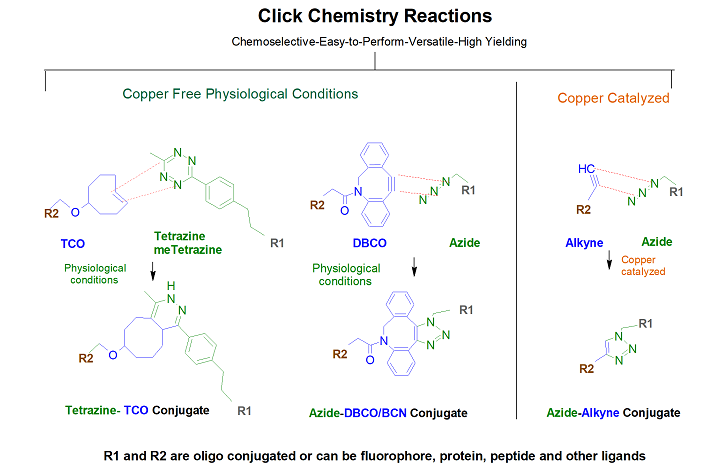.png)
Modification : Azide dG
Catalog Reference Number
Category
Modification Code
5 Prime
3 Prime
Internal
Molecular Weight (mw)
Extinction Coeficient (ec)
Technical Info (pdf)
Absorbance MAX
Emission MAX
Absorbance EC
26-6765G
Click Chemistry
[N3-dG]
Y
Y
Y
370.22
11.5
26-6765G.pdf
-
-
-
| Catalog No | Scale | Price |
| 26-6765G-05, | 50 nmol | $206.00 |
| 26-6765G-02, | 200 nmol | $206.00 |
| 26-6765G-01, | 1 umol | $335.00 |
| 26-6765G-03, | 2 umol | $410.00 |
| 26-6765G-06 | 5 umol | $820.00 |
| 26-6765G-10, | 10 umol | $1,432.00 |
| 26-6765G-15, | 15 umol | $1,790.00 |
| Discounts are available for Azide dG! |
| Modification* Discount Price Structure |
|
1 site/order
|
List price
|
|
2 sites/order
|
10% discount
|
|
3 sites/order
|
20% discount
|
|
4 sites/order
|
30% discount
|
|
5-9 sites/order
|
50% discount
|
|
10+ sites/order
|
60% discount
|
|
*Exceptions apply
|
Click here for a complete list of Click Chemistry Oligo Modifications
Click Chemistry Modifications
Use azide modified oligos with Alkyne or DBCO Cyclooctyne- or BCN modifications for ease of copper catalyzed or copper-free click reagents. These are simple to use and has excellent click performance in 17 hours or less at room temperature. Gene Link offers numerous azide, alkyne, DBCO, BCN, TCO and tetrazine modifications for designing an oligo for your click applications.
The presence of the azide allows the user to use "Click Chemistry" (a [3+2] cycloaddition reaction between alkynes and azides, using copper (I) iodide as a catalyst) to conjugate the azide-modified oligo to a terminal alkyne-modified oligo with extremely high regioselectivity and efficiency (1,2). Preparation of the alkyne-modified oligo can be achieved using the 5'Hexynyl modifier (see its respective tech sheet for details). Click chemistry can be used to form short, cyclic oligos that can be used as research tools in various biophysical and biological studies (3). In particular, they have considerable potential for in vivo work, as cyclic oligos are known to be very stable in serum for up to several days.
 References
References
1. Huisgen, R.
Angew. Chem. Int. Ed. (1963),
2]: 565-568.
2. Rostovtsev, V.V., Green, L.G., Fokin, V.V., Sharpless, K.B. A Stepwise Huisgen Cycloaddition Process: Copper(I)-Catalyzed Regioselective Ligation of Azides and Terminal Alkynes.
Angew. Chem. Int. Ed. (2002),
41: 2596-2599.
3. Kumar, R., El-Sagheer, A., Tumpane, J., Lincoln, P., Wilhelmsson, L.M., Brown, T. Template-Directed Oligonucleotide Strand Ligation, Covalent Intramolecular DNA Circularization and Catenation Using Click Chemistry.
J. Am. Chem. Soc. (2007),
129: 6859-6864.
- Azide dG (8-Azide dG)
